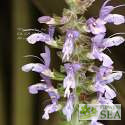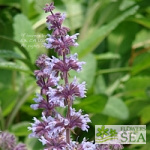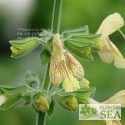Quick Digs: Zone 5 - 9 Weedbuster Gardens for Average Moisture

Quick Digs is a serial containing short posts focused on a central issue of Salvia gardening. The topic for the first series is Salvia groundcovers for weed control, and this is the second article.
Baby, it can be cold outside in Zone 5 during the winter! But the roots of all of the tough Salvias (true sages) listed here survive sustained frost and snow, then rise up again in the spring.
To minimize weed growth, the best defense is the good offense of dominating a flowerbed with sages. Although much research is yet to be done, it appears that Salvia plant chemicals and growing patterns deter weed growth. Mixing in an efficient groundcover sage that forms dense clumps of foliage makes it tougher for weeds to gain ground. Don't forget that Salvias need good soil drainage for healthy root growth.
Here are brief profiles of some of our favorite, powerfully fragrant sages that tolerate cold and grow well in full sun to partial shade.
Groundcover
Caucasus Sage (Salvia canescens var. daghestanica) Zones 5 to 9.
- Royal purple flowers bloom spring to summer
- 4 to 12 inches tall, 12 inches wide
- Full sun
- Attracts bees
- Deer resistant
Border
Jupiter’s Distaff (Salvia glutinosa) Zones 5 to 9.
- Yellow flowers bloom in summer
- 24 to 36 inches tall, 24 inches wide
- Full sun to partial shade
- Attracts butterflies and honeybees
- Deer resistant
Lilac Sage (Salvia verticillata) Zones 5 to 9.
- Lavender flowers bloom spring to summer
- 24 to 36 inches tall, 42 inches wide
- Full sun to partial shade
- Attracts butterflies and honeybees
- Deer resistant
Balkan Sage (Salvia forsskaolii) Zones 4 to 9.
- Lavender flowers bloom summer into fall
- 36 to 48 inches tall, 36 inches wide
- Partial shade or morning sun/afternoon shade
- Attracts honeybees and hummingbirds
- Deer resistant
Himalayan Cloud Sage (Salvia nubicola) Zones 5 to 10.
- Yellow flowers with purple markings bloom in summer
- 48 inches tall, 36 inches wide
- Full sun to partial shade
- Deer resistant
Mid-summer through fall is a fine time for planting sages. Most of these plants likely won't bloom until next season. However, gardening is an act of faith in beauty to come. Don't hesitate to contact us for information and encouragement.

 Salvia forsskaolii
Salvia forsskaolii  Salvia verticillata
Salvia verticillata  Salvia glutinosa
Salvia glutinosa
Comments
There are no comments yet.